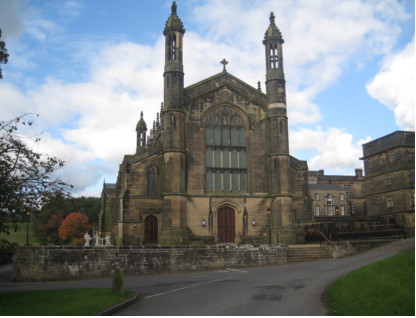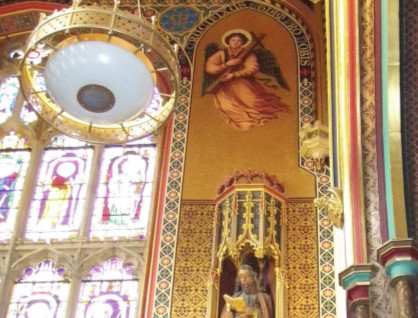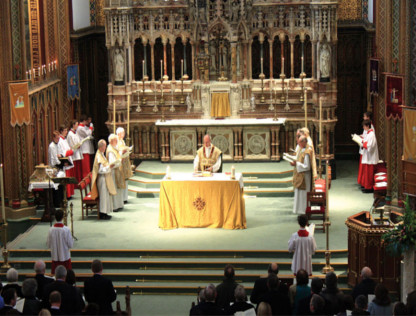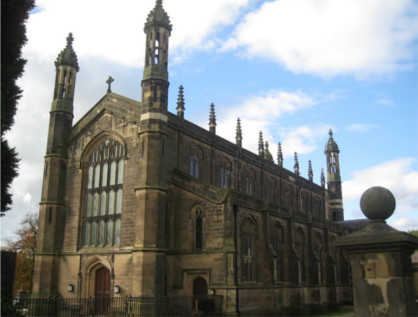St Peter's
St Peter's has recently undergone a major refurbishment of the church, including a new roof and the stained glass windows restored in all their glory. Details and photographs are available on the Stonyhurst College website here. There are some more photographs and a list of the refurbishments at Cassidy Ashton. Cassidy Ashton have also prepared two display boards which are reproduced here board1 and board2 in pdf format.
A Potted History of the Parish of Stonyhurst
(Based largely on the researches of Fr Freddie Turner S.J. one time headmaster)
In 1372 John Bailey obtained a licence to have an oratory at Stonyhurst. His son married a Shireburn and adopted the name. In 1590 Sir Richard Shireburn started building a substantial house, including a chapel, the present Bayley Room. During penal times, the Shireburns, and later the Welds, maintained a missioner to minister to the needs of the local Catholics, and Stonyhurst and Hurst Green seems to have been totally Catholic during this time. From the time of the Second Catholic Relief Act of 1791 there was a growing confidence among English Catholics and from 1784 we find baptismal registers being preserved. In 1794 Thomas Weld left the rather neglected Stonyhurst to the exiles of the ex-Jesuit college in Liege. The story of how these boys, led by their ex-Jesuit teachers made the journey from Liege, across the North Sea and then trekking cross country to Stonyhurst is an epic. From that time on, the missioner was appointed by, and was member of, the Stonyhurst ex-Jesuit Community, "The Gentlemen of Stonyhurst".
It should be noted that what existed during penal times was not just a Mass-centre. From 1686 it also included a catholic school-- the present St. Joseph's school. The year 1794 marks the beginning of Stonyhurst College, but also marks the establishment of one of the earliest Catholic Guilds since the Reformation. So what was the size of the mission at this time? We can only guess from the facts we have: in 1784 Bishop Gisbon confirmed 77 candidates and there were 220 communicants. Just twelve boys arrived on that day in August in 1794, but by May 1797 there were eighty.
Increasing numbers put a strain on the old Shireburn Chapel, and one of the community, a sort of bursar, "a bull of a man" who had little aesthetic sense, had the answer. He converted the old Shireburn stables into what became known as "The Barn Church" (occupying the site of the present sacristy).
Meanwhile the Hurst Green Guild received official approval under the title of "The Society of Good Fellowship". In 1840 it was renamed "the Guild of ST Peter", but already, in 1836, the Guildhall was built, known usually simply as "The Club".
In 1819 a subscription was opened to finance the building of a new church to replace the Barn Church. The architect who was chosen was J.J Scoles. After the Second Catholic Relief Act it was possible for Catholic churches to be built, but there were restrictions: they were not to have a tower or steeple, nor where they to have bells. St Peter's was completed and consecrated in 1835 as the "Collegiate Church of the Society of Jesus at Stonyhurst". It was one of the earliest churches to be consecrated in this country since the Reformation.
Before 1825 there had been a serious problem about burials: if Catholics were to be buried in a graveyard it had to be that of the Anglican Church, and with the consent of the local vicar. Some Catholics were buried in unconsecrated ground, though many Hurst Green Catholics were buried at Mitton. This was put right when Thomas Weld (later Cardinal Weld) donated land at the top of the avenue for a cemetery and built a handsome mortuary chapel.
The Church of st Peter has not changed significantly since its foundation, except for some interior decoration and the enlargement of the sanctuary. In 1893 the present large marble altar was erected in to replace the smaller previous altar which was re-erected in St Joseph's in Hurst Green. There were continual alterations to the Hurst Green school in 1860, when Fr Walker was missioner, these became known as Walker's Castle.
Between 1867 and 1870 St Joseph's Chapel was built. In 1875 Fr Myers, who was missioner for 30years, bought a farm at Dutton Lea which became a catechetical centre staffed by young Jesuits studying at St Mary's Hall. In 1945, because of the petrol shortage, the bishop gave permission for Mass to be celebrated there, and this continued for forty years when it was considered no longer necessary.



